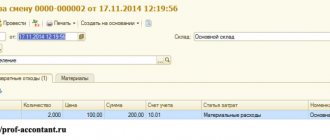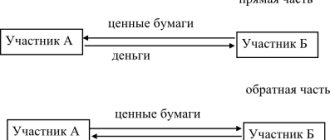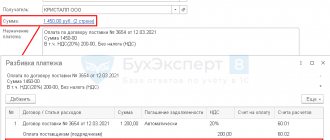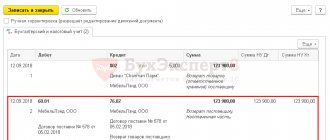Home / Complaints, courts, consumer rights / Consumer rights
Back
Published: 10/18/2018
Reading time: 7 min
0
329
An invoice is usually prepared by the seller of the goods and contains the amount that the buyer must pay to the supplier for the goods or service, including the allocated amount of VAT, as well as the details of the seller.
- What is an invoice
- Invoice for returning goods
- Full refund
- Partial return of goods
When an invoice is issued when goods are returned to a supplier, it has its own characteristics.
Returning goods: as before
Since 2021, there have been changes that relate to processing the return of goods. But first, let’s remember what order was applied earlier, before the changes came into force.
Until 2021, the important point was whether the buyer registered the purchased item in his program.
In the case when the buyer managed to accept the goods for registration and, if necessary, return them, he had to make a return sale. This means that the buyer generated an invoice for the returned goods, indicated himself as the seller and entered the document into his sales book. That is, a full-fledged implementation was obtained with all the consequences.
If the buyer did not have time to take into account the received goods, and the need to return arose, then the seller only had to create an adjustment invoice.
This order was quite simple, harmonious and logical. In fact, the return procedure depended on who had ownership of the product. Whoever is the owner of the goods issued the adjustment document. This procedure for processing returns has existed for many years, and each of the parties involved in the return procedure knew exactly what was required of it. Currently, one is getting used to the new scheme and sometimes confusion arises.
The buyer returns all goods not accepted for accounting in the general mode
In the previous section, we looked at the situation when the buyer returns some of the goods that were not accepted for accounting. And when returning the entire unaccounted for shipment, the procedure will be different: the buyer does not register an invoice for this operation (see diagram 3).
Accounting with the supplier . There is no need to issue an adjustment invoice. In it, the company reduces the cost of shipped goods. In this situation, the shipment is cancelled. Nevertheless, the supplier has the right to claim a deduction from the cost of returned goods (clause 5 of Article 171 of the Tax Code of the Russian Federation). To do this, you can register an invoice that the supplier previously issued for shipment in the purchase book.
Accounting with the buyer . Since the buyer rejected the shipment of goods, he does not claim a tax deduction. The buyer does not register the supplier's shipping invoice in the purchase book.
How to return goods from 2021
The legislator wanted to slightly simplify the procedure for returning goods, although it would seem much simpler. In this regard, some changes were made at the legislative level. Changes regarding returns apply to returns made after April 1, 2021.
Now the procedure for processing returns depends on the agreement under which the return is being made.
In most cases, the purchase of goods and its return occur within the framework of one contract. In this situation, the legislator simplified the life of buyers and established that regardless of whether the goods are accepted for accounting or not, the buyer does not generate an invoice. Now the seller performs all the actions. He accepts the returned goods and issues an adjustment invoice. Moreover, using such a system, you can return both high-quality and low-quality goods.
A less common situation is when the buyer returns the goods under a separate agreement. In this case, the former buyer becomes the seller and transfers the goods according to a regular invoice. At the same time, the former seller, and now the buyer, does not draw up any documents.
It is also necessary to take into account that currently it does not matter what taxation regime the seller and buyer are in. If the seller pays VAT, and the buyer is in a special regime, then when returning the goods, the seller simply issues an adjustment invoice and takes it into account. It turns out that the same document is counted twice.
It must be borne in mind that there have been no critical changes in the invoice form. The only and significant innovation of the document is the tax rate, which increased from 18% to 20% in 2021 compared to 2021.
Simple invoice
In practice, a situation is possible when the buyer resells the goods to the seller. That is, the former buyer becomes a seller. In this case, an invoice for the return of goods is issued as follows.
The former buyer draws up a regular invoice and transfers this document to the seller in the general manner (clause 1 of Article 39, subclause 1 of clause 1 of Article 146 of the Tax Code of the Russian Federation). The correctness of this approach is confirmed by officials (see, for example, letters from the Ministry of Finance dated April 15, 2019 No. 03-07-11/26696, dated April 10, 2019 No. 03-07-09/25208).
If the seller did not issue an invoice when selling goods, then upon return an accounting certificate is drawn up, which serves as an adjustment document. This situation may arise if the seller applies a special regime, received an exemption from VAT, etc. Such an adjustment document must be registered in the purchase book (subclause “z” of clause 6 of the Rules, approved by Government Decree No. 1137 dated December 26, 2011, clause 1.4 of the Federal Tax Service letter dated October 23, 2018 No. SD-4-3/20667).
Read also
25.10.2018
Accounting for the return of goods from the supplier
When returning goods, in most cases the seller has to prepare a corrective invoice. At the same time, at the moment when the goods are actually accepted back, an entry is made in the purchase book. Accordingly, VAT on such a document can be deducted, and there will be no need to correct the declaration for the previous period.
It must be remembered that if only part of the goods is returned, the seller issues an adjustment invoice - an invoice, which is registered in the purchase book and corrects the amount of VAT payable to the budget.
It should also be noted that in connection with the change in the tax rate from 2021, the tax service indicated that when drawing up a corrective invoice, the rate that appeared in the original document is indicated.
Regarding income tax. In the case when the goods were purchased and returned in different periods, at the time of return of funds to the buyer’s account, non-operating expenses are accepted.
Corrective
If the goods are returned according to the terms of the contract, the seller must issue an adjustment invoice. Issuing an invoice when returning goods to the supplier has become mandatory since April 1, 2019 (clause 3 of the Rules for maintaining a sales book, approved by Government Decree No. 1137 dated December 26, 2011). That is: now a correction invoice is always issued. Based on it, the seller and buyer recalculate the tax base and the amount of VAT deductions.
Please note that issuing an adjustment invoice when returning goods is required (letter from the Ministry of Finance dated 02/04/2019 No. 03-07-11/6171, Federal Tax Service dated 05/29/2019 No. SD-4-3/10321):
- both when returning defective and quality goods;
- both when returning the entire lot or part of it;
- when the buyer accepts the goods for registration, it is not.
It is clear that when issuing an adjustment invoice when returning goods in 1c, the seller reduces the quantity and cost of the goods supplied and the amount of tax charged to the buyer. To accept VAT as a deduction, the seller must register the document in the purchase ledger.
In turn, the buyer registers an adjustment invoice in the sales book and restores the tax previously accepted for deduction from the cost of returned goods (letters from the Ministry of Finance dated 04/15/2019 No. 03-07-11/26696, dated 04/10/2019 No. 03-07- 09/25208).
Reflection of returns in the seller's accounting
Like any other fact of the economic life of an organization, returns must also be reflected in accounting. Moreover, entries made earlier will have to be reversed. The reversal will have to be made according to the following postings.
| Operation | Contents of operation |
| D62 K90/Revenue | The amount of revenue is reversed by the cost of goods that were returned |
| D90/Cost price K41 | A reversal of the cost that was written off for returned goods is carried out. |
| D90/VAT K68/VAT calculations | VAT is deductible from the cost of goods that were returned. |
Accounting for the return of goods from the buyer
In any case, when returning goods, the buyer receives an adjustment invoice.
Further, the procedure depends on whether the returned goods were accepted for accounting or not.
If the goods have not yet been accepted for registration, no problems arise. The operation was not performed, which means there is nothing to fix. Therefore, no action is necessary in this case.
If the goods are accepted, then based on the received invoice, you need to restore the VAT, which will be deducted upon purchase. The invoice goes into the sales book.
If the buyer, when accepting the goods, decided that for some reason part of it should be returned back to the seller, then the document originally issued should be taken into account, but without taking into account the cost of the goods to be returned. When an adjustment invoice is received from the seller, there is no need to register it with an invoice.
As for income tax, no corrections will be needed, since the goods will not yet have time to be included in expenses.
Part 2. Invoice: actions and operations when returning goods by the buyer
1. Return of part of the goods not accepted for accounting
If the buyer returns goods that are not accepted for registration, the seller issues an adjustment invoice for the reduction in value. It should be borne in mind that adjustment invoices are applied only if the buyer returns to the seller part of the goods not accepted by him for accounting. If the buyer refuses to accept the entire shipment, then the seller, in order to claim a tax deduction, registers in the purchase book his own invoice issued upon shipment of the goods. (see letter of the Federal Tax Service of Russia dated April 11, 2012 No. ED-4-3 / [email protected] ).
If, upon acceptance of the goods, the buyer discovers a defect, a mismatch, or for some reason (specified in the contract) decides to return the goods to the supplier, then, again, as in paragraph 3, this product must be accepted for safekeeping.
Further, all actions of the buyer and supplier are similar to actions in the event of a short supply of goods detected before the goods were accepted for accounting (clause 1 of Section I)
In addition, when returning, the buyer draws up a “Return of goods to supplier” document.
2. Return of the entire batch of goods not accepted for accounting
If the buyer refuses to accept the entire shipment, then the seller, in order to claim a tax deduction, registers in the purchase book his own invoice issued upon shipment of the goods. (see letter of the Federal Tax Service of Russia dated April 11, 2012 No. ED-4-3 / [email protected] ). To do this, the seller in the program:
a) Enters the document “Return of goods from the buyer.” On the VAT tab, the flag “The buyer issues an invoice for the return” is not set; the return must be reflected in the purchase book.
In this case, the buyer accepts the goods for safekeeping, then when shipping these goods back to the supplier, enters “Return of goods to supplier”. There is no need to fill out any documents related to VAT in the program.
3. Return of goods accepted for registration.
The return of goods accepted for registration by the buyer is processed as a return sale. Those. the buyer, now acting as a seller, calculates the amount of VAT on the returned goods, issues an invoice for the sale and registers it in the sales book. And the former seller, upon receipt of the invoice, has the right to deduct the amount of VAT on the returned goods, reflecting it in the purchase book.
Accounting with the seller:
a) A document “Return of goods from the buyer” is generated, in which the flag “The buyer issues an invoice for the return” is placed on the “VAT” tab and the invoice is entered using the link, which indicates the entry number and date of the invoice received from a former buyer.
b) In this case, when automatically filling out the document “Creating purchase book entries” in the program on the “Deduction of VAT on purchased values” tab, a line will be generated for the returned goods, where the former buyer will be presented as the supplier:
c) Based on the data in this document, a printed form of the purchase book will be generated, with a registered line of the invoice for return from the buyer.
Buyer's account:
a) a document “Return of goods to the supplier” is generated, in which the “VAT invoice is issued to the supplier” flag is placed on the “VAT” tab and the invoice is entered using the link.
b) This invoice must be reflected in the sales ledger. To do this, enter the document “Creating sales book entries”, in which, when automatically filled in on the “On sales” tab, a line will be generated for charging VAT on the returned goods, where the former seller will be presented as the buyer:
Because the return in this case is similar to a regular sales transaction, then there is no need to adjust tax liabilities and deductions for the period of sale of goods.
Reflection of the return in the buyer's accounting
Here again, everything depends on whether the goods were accepted for accounting.
If the goods are not registered, then no postings are required or made.
Otherwise, the following entries must be reversed.
| Operation | Contents of operation |
| D41 K60 | Reversal of the cost of the returned item |
| D19 K60 | Reversal of VAT that was received with the purchase of goods |
| D68/VAT calculations K19 | VAT, previously accepted for deduction, has been restored |
What other documents are needed to return goods?
It should be borne in mind that the list of documents that need to be completed when returning goods has not undergone any changes. In order to return the goods, it is not enough to simply draw up an adjustment invoice.
Most often, a product is returned if it is of inadequate quality or a mismatch is detected. In this case, a document such as a statement of discrepancies is drawn up. If it is drawn up in the presence of the supplier, then his signature is placed on the document.
A claim is also drawn up, which contains a convincing request to accept the goods back, indicating the reason for the return and the quantity of the goods. Another document that is drawn up when returning is a return invoice. It should also indicate which product and in what quantity can be returned.
The report, along with the claim and return invoice, is sent to the supplier. The supplier, in turn, must accept the returned goods and at the same time make a note on the return label. The usual TORG-12 can be used as a return invoice, on which a note is made that such an invoice is a return one.
As you can see, returning an item is not that difficult. From 2021, a new procedure for processing the return of goods will be applied. This procedure applies to returns made after April 1. The burden of creating an adjustment set - invoice - lies entirely with the seller of the goods, who accepts the return. When making a return, you should be very careful about the formation of primary documents so that the regulatory authorities do not have any complaints.







